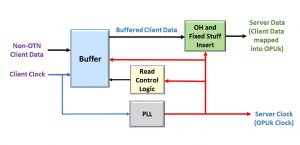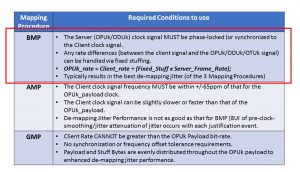What is the BMP (Bit-Synchronous Mapping Procedure)?
This post describes the BMP (Bit-Synchronous Mapping Procedure) for mapping a non-OTN CBR (Constant Bit Rate) client signal into an OPUk/ODUk signal.
NOTE: Whenever ITU-T G.709 discusses procedures for mapping a client signal into an OPUk/ODUk signal, it will often refer to the OPUk/ODUk signal as the Server signal.
Therefore, we will use the terms OPUk/ODUk and Server interchangeably throughout the remainder of this post.
ITU-T G.709 also defines two other mapping procedures that one can use to map a non-OTN CBR client signal into a Server signal.
(*) – Requires membership to THE BEST DARN OTN TRAINING PRESENTATION…PERIOD!! to see this post.
We discuss each of these other two mapping procedures in other posts.
What is the Bit-Synchronous Mapping Procedure?
The name Bit-Synchronous Mapping Procedure means that there is a bit-synchronous relationship between the client signal (that we are mapping into an OPUk payload) and the bit rate of the OPUk payload.
In other words, the System Designer must ensure that ALL the following conditions are true before they can use the Bit-Synchronous Mapping Procedure to map a particular client signal into the OPUk payload.
- The OPUk/ODUk/OTUk clock signal must be phase-locked (or synchronized) to the client clock signal, as Figure 1 illustrates below.

Figure 1, Illustration of the Synchronization Requirements (between the OPUk/ODUk/OTUk signal and the client signal) to use BMP
- We must use fixed-stuffing to handle rate differences (between the Client signal and OPUk/ODUk/OTUk signal).
- In other words, we insert a fixed number of bits/bytes into the Server (OPUk) payload, along with the client data.
- OPUk_rate = Client_rate + (Fixed_Stuff x Server_Frame_Rate);
- In other words, we insert a fixed number of bits/bytes into the Server (OPUk) payload, along with the client data.
- Client bit-rate tolerances MUST NOT exceed the Server bit-rate tolerances.
- For example, if the bit-rate tolerance for an OPUk is +/-20ppm, then the Client signal’s bit rate tolerance cannot exceed +/-20ppm.
New Comprehensive OTN Training…Available Now. Click on the Banner Below to Learn More!!!
Discounts Available for a Short Time!!
ITU-T G.709 Recommendations on Using BMP
ITU-T G.709 recommends using BMP when mapping the following non-OTN Client Signals into each of the OPUk/ODUk Structures listed below in Table 1.
Table 1, List of Client Signals that ITU-T G.709 Recommends using BMP when mapping into an OPUk Structure

BMP and De-Mapping Jitter
BMP offers the best de-mapping jitter of the three recommended Mapping Procedures.
Fixed stuffing and the presence of the OTUk/ODUk/OPUk overhead bytes are the only contributions to mapping (and de-mapping jitter). Justification events (which imposes 8UI-pp of mapping-related jitter) for AMP applications do not occur in BMP.
However, the System Designer will still need to implement a clock-smoothing or jitter attenuation scheme to comply with de-mapping jitter requirements.
This requirement is especially true for SONET/SDH applications.
Summary
Finally, Table 2 summarizes the timing requirements (between the Client Clock Signal and that for the OPUk/ODUk clock) that the System Designer must comply with before using any ITU-T G.709 Recommended Mapping Procedures.
Please note that I have highlighted the BMP items below with a “Red Rectangular” outline.
TABLE 2, MAPPING PROCEDURE TIMING REQUIREMENTS

Has Inflation got You Down? Our Price Discounts Can Help You Fight Inflation and Help You Become an Expert on OTN!! Click on the Banner Below to Learn More!!!
Discounts Available for a Short Time!!!
For More Information on OTN Posts in this Blog, click on the Image below.




